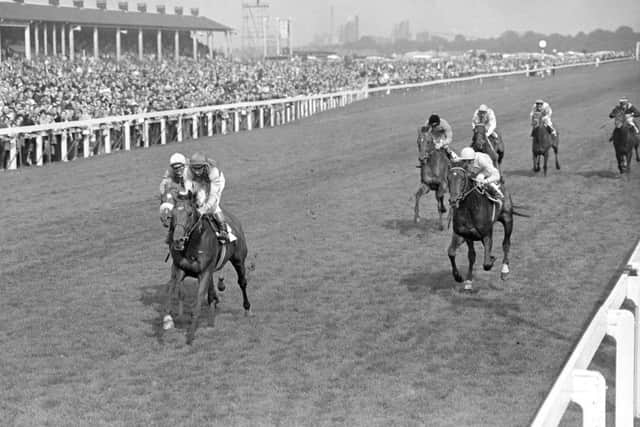Bygones – How playful Lester Piggott cemented ‘genius’ reputation in 1984 St Leger win at Doncaster on Commanche Run


“Not even a good day for playing tennis,” mumbled the normally monosyllabic racing legend to, among others, The Sun’s racing correspondent Claude Duval.
The playful Piggott was referring to the American jockey Darrel McHargue who he had ‘jocked off’ in order to ride the favourite in the 1984 renewal of the world’s oldest Classic.
Advertisement
Hide AdAdvertisement
Hide Ad

McHargue – first jockey to then up-and-coming trainer Luca Cumani – had reacted by announcing that he intended to play tennis rather than watch the drama on Town Moor. He would soon return to the USA after the perceived humiliation.
This, after all, was the race in which Piggott, then 48, drew on every ounce of his experience to land a historic 28th Classic and usurp a record that saddler’s son Frank Buckle had held since 1827.
Advertisement
Hide AdAdvertisement
Hide Ad

“No present day jockey could have extracted more effort from Commanche Run – and this without heavy reliance on the whip – or judged the pace more accurately than Piggott did,” The Yorkshire Post eulogised.
Thirty years after Piggott had won the first of a record nine Epsom Derbies on Never Say Die as a ‘boy wonder’ 18-year-old, the build up to the 1984 St Leger, the first to be sponsored, was extraordinary.
Advertisement
Hide AdAdvertisement
Hide AdPiggott – who is due to be at Doncaster this Wednesday for the Leger Legends charity race – had gained a reputation over the years for being ruthless when it came to securing big race rides.


Piggott’s powers of persuasion were at odds with his public persona and economy of words. As Duval was once told by leading owner Charles St George: “When you have Lester riding for you, not only have you got the best jockey but you’ve not got him arriving on the scene riding against you.”
Yet, in 1984, Piggott’s career was thought to be approaching the final furlong and he was lucky to escape serious injury at Leicester when a foot became stuck in the riding irons.
The late journalist John Oaksey described how Piggott was “towed for 50 terrifying yards”.
Advertisement
Hide AdAdvertisement
Hide Ad“Five weeks later, he was back – for his 28th Classic on Commanche Run,” he reported in his book Oaksey On Racing.


“That ride, like many others, was, of course, ruthlessly obtained at another man’s expense. Heroes are not often saints and Lester Piggott’s character is a coin with at least two sides. Public relations has never been Lester’s strongest point – probably for the first rate reason that there are only a tiny handful of people in the world about whose opinion of him he gives a damn.”
Commanche Run was owned by Singapore-based businessman and trainer Ivan Allan, who had turned to Piggott for the horse’s runway win in Goodwood’s Gordon Stakes when McHargue was suspended.
The question was who would get the ride in the St Leger?
In his autobiography, Piggott says he was “without a definite ride” a week before the St Leger and Commanche Run was “a real possibility”.
Advertisement
Hide AdAdvertisement
Hide Ad“As was his prerogative, Ivan Allan asked me if I’d be available and, when I indicated that I would be, he insisted that I ride,” he added.
“An announcement to that effect was made on the Tuesday evening before the big race on the Saturday and caused the usual complaints about Piggott jocking off a fellow rider.”
Yet Yorkshire-born Derek Thompson, a presenter on Channel Four Racing, has a different theory.
“Though Darrel was top class, the majority of his rides were from five furlongs to a mile and a quarter,” he told this newspaper.
Advertisement
Hide AdAdvertisement
Hide Ad“I don’t think he had ridden over the St Leger trip of one and three-quarter miles. The fact is Lester was going for the record, and he was a friend of the owner, and that probably clinched it.”
There was a further complication when Commanche Run stumbled and injured his knees days before the race – he was only declared fit on St Leger day.
A first English Classic win for the Italian-born Cumani whose daughter Francesa now presents ITV Racing, this was overshadowed by Piggott’s genius in the saddle. Backed into favouritism on a tide of public sentiment, the jockey had already sensed – from his ride at Goodwood – that Commanche Run would keep up a sustained pace rather than produce one decisive burst of acceleration.
His instincts, as always, were right.
Prominent throughout, he took up the running entering the long home straight.
Advertisement
Hide AdAdvertisement
Hide Ad“About three furlongs out, I upped the tempo a little more and from then on just kept Commanche Run up to his work as a succession of challengers tried in vain to get past him,” he recalled.
The most serious came from Steve Cauthen, the top American jockey, on the Aga Khan’s Baynoun – and they looked like spoiling Piggott’s party with a furlong to go. Yet, as Thompson observed, Piggott had perfect balance in the saddle – and also the strength to keep Commanche Run in a straight line.
“I don’t think anybody else could have won on that horse. We used to have dinner. They’d be eight of us in Mayfair. We’d all order steak and chips, while Lester would sit there with a glass of Champagne and a cigar,” he added. “After Commanche Run’s win I think I saw him smile – but I wouldn’t put money on it!”
The warmth of the ovation registered with Piggott who says he was “genuinely surprised”.
“I didn’t realise they cared so much,” he quipped.
Piggott also said that he had no intention of retiring.
“One more year and, perhaps, more Classics,” he ventured.
Advertisement
Hide AdAdvertisement
Hide AdHe was as good as his word. Shadeed won the following year’s 2000 Guineas at Newmarket – while Commanche Run would win the 1985 Benson and Hedges Gold Cup at York – hung up his riding boots
Yet, after imprisonment for tax evasion, the rider made a remarkable return to the saddle in 1990 and a 30th, and final Classic followed when Rodrigo De Triano landed the 1992 Guineas.
“An amazing man – and there will never be another Lester Piggott,” added Thompson.
By comparison, Frankie Dettori – the current number one jockey – has, at the age of 48, a mere 18 Classics to his name.
Advertisement
Hide AdAdvertisement
Hide AdThis, says the aforementioned Duval, is further proof of Lester Piggott’s greatness.
“I can still see him by the old weighing room saying ‘Not even a good day for playing tennis’,” he added.
“The great Yorkshire crowd were on his side. They realised that he had won more Classics than anyone else and celebrated the feat as only a Doncaster crowd could – Commanche Run had been backed into favouritism as soon as L Piggott had been booked. It was a very popular win – apart from one man sitting in his tennis gear watching it rain.”
How Lester Piggott transformed the role of the big ride jockey
Advertisement
Hide AdAdvertisement
Hide AdRACING historian Tony Barber believes Lester Piggott changed the sport with his pursuit of high-profile rides.
“Famed as the jockey without equal as regards winning big races, owners and trainers sought his services avidly,” he wrote in The St Leger, an acclaimed history of the race. “Piggott was thus able to select rides on the basis of quality and not quantity. By placing himself in such a position, he had transformed the role of a jockey.
“Historically, riders had been largely at the beck and call of their superiors – whether as grooms, as in the 18th century, or well-paid professionals in the 20th.
“Now Piggott operated with a level of independence hitherto unknown – brokering his own deals and pursuing much of his business directly by telephone. As might be expected, he conducted his affairs with the same degree of ruthlessness he displayed in his riding.”
Advertisement
Hide AdAdvertisement
Hide AdThe St Leger, inaugurated in 1776, is the oldest of England’s five Classics which also include the 1000 Guineas, 2000 Guineas, Oaks and Derby.
Commanche Run was the last of Piggott’s eight St Leger victories, one behind the nine accrued by Bill Scott in the 1800s. The first was St Paddy in 1960, while the most famous was Nijinsky’s Triple Crown win in 1970.